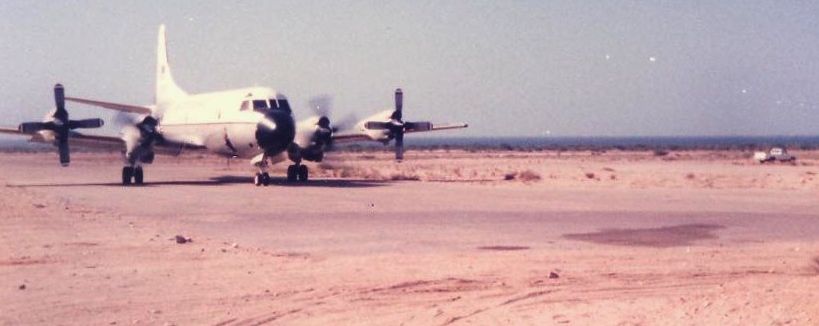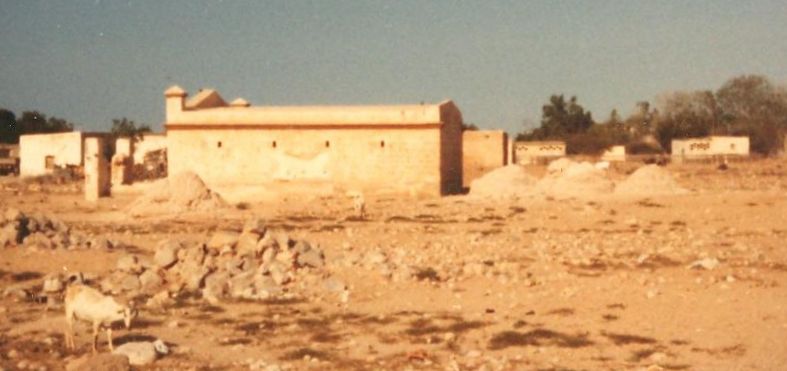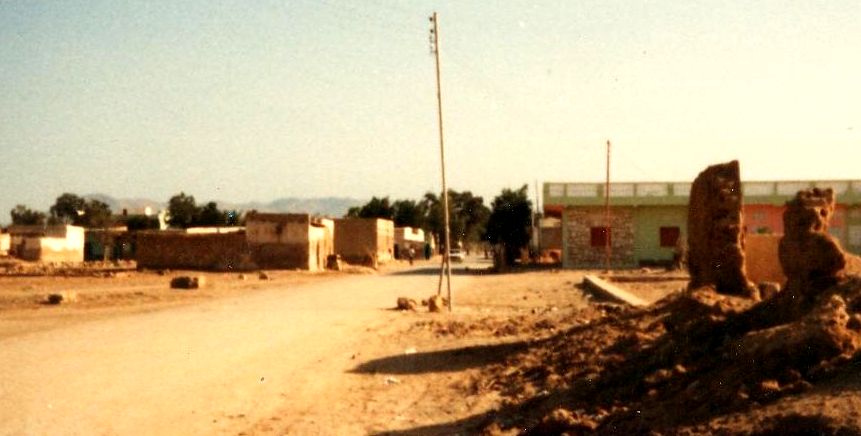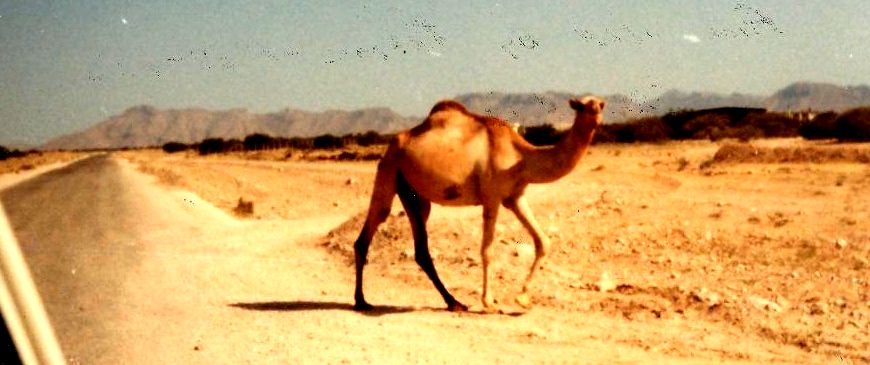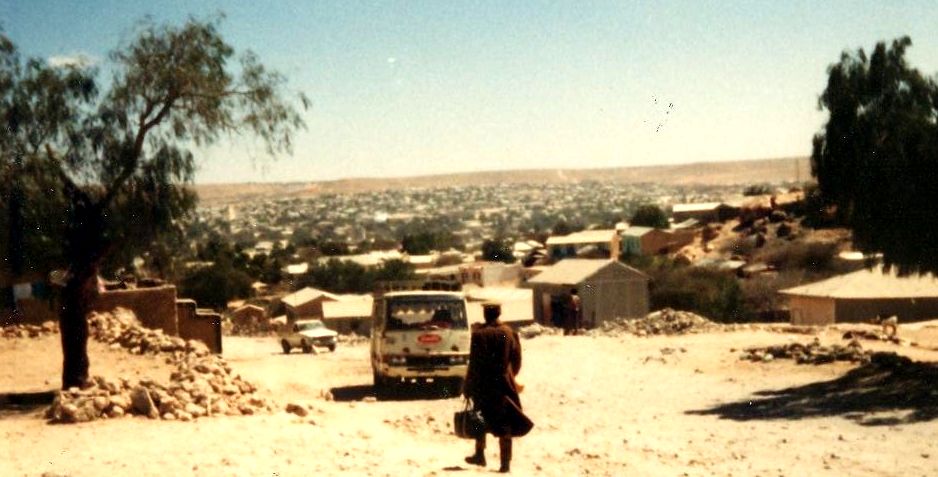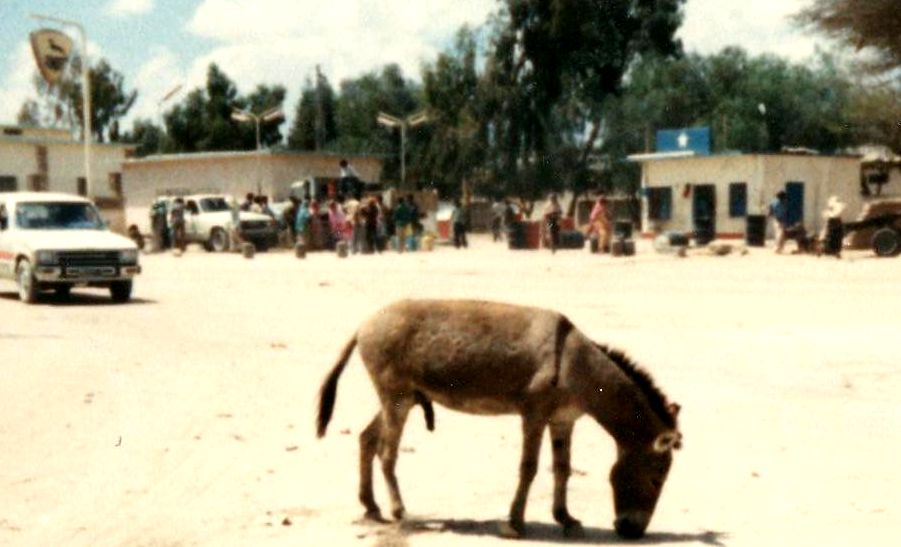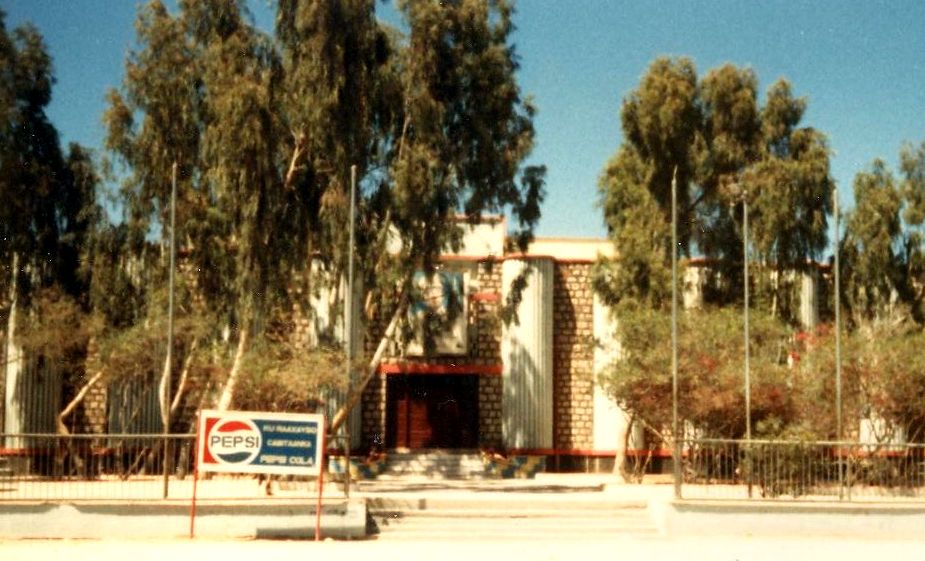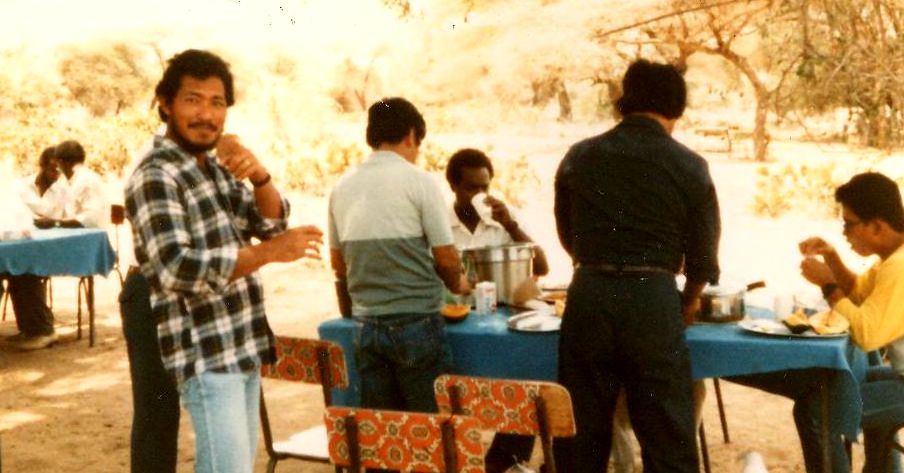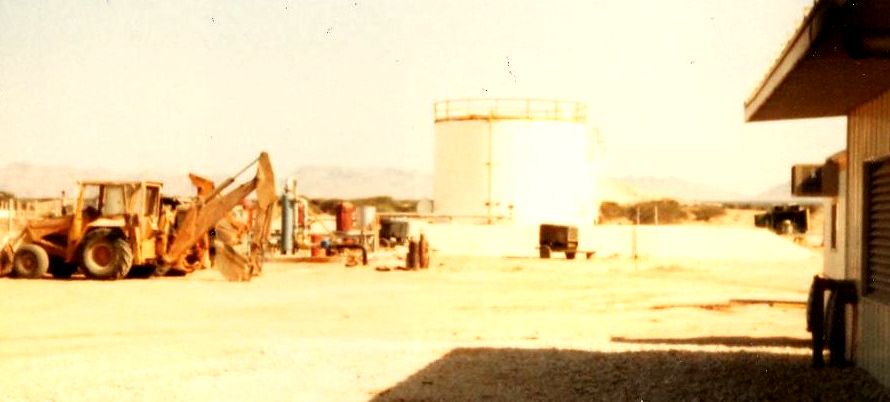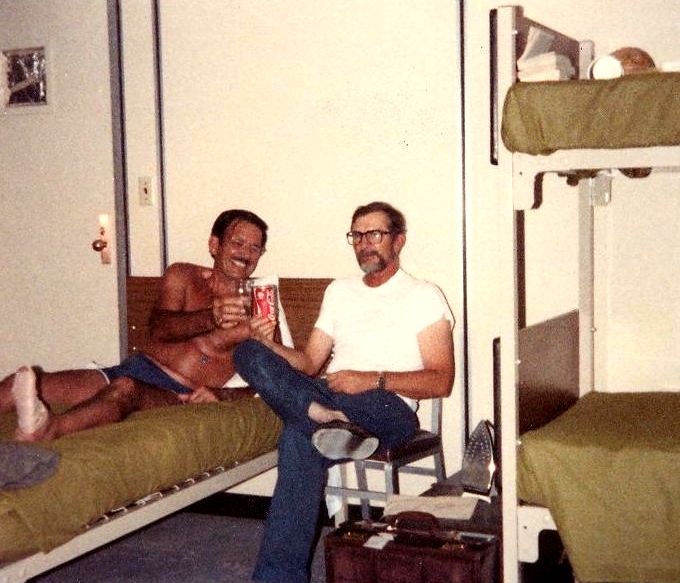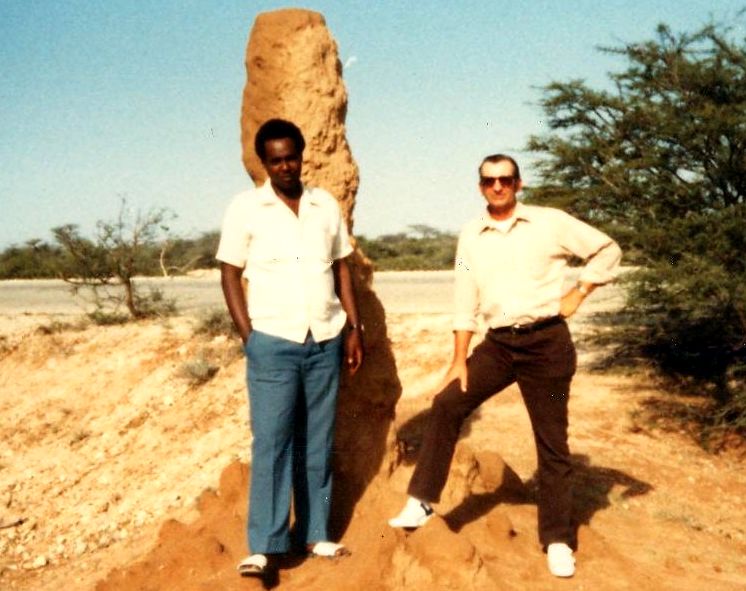I was the Fuels
Maintenance Super, From 1985 to 1988 at DG and
Berbera, Somalia. I was the last US at Berbera to
get on the plane when they pulled us out Dec 1991
and then closed the Navy annex and Base at
Berbera.
I
was also one of the first US to go into Somalia
at BERBERA in June 1984. The Contractor
was there doing his thing, small fuel tank farm,
25,000 BBL Storage Tanks at the Fuel Farm, about
8 NM from the airfield. Storage tanks at
the airfield and buildings were built. No
hot water, wash clothes in cold water and hung
on bush to dry. FEBROE sent us in, 5 TCNs
and two US, not much. For three months once our
good AF would not land at BERBERA we ran out of
food, lived on spare ribs , rice, onions, and
fish from the Red Sea, that's if we could catch
them. It wasn't a very safe place to be,
but the pay was 50% more, so we liked that
part. I arrived in Somalia at 196 LBS, and
arrived in Diego Garcia at 138lbs.
Good. Ha.
It
was
a mess getting out of Somalia, I had back to
back tankers picking up Jet Fuel, me and one
TCN, each ship, one day apart, up 72 stright
hours on each, the other guys. Not the
In-Country Manager, he never did a thing.
Packed up what we could, C-5 came in two days
after X-mas of 90. The Air Force would not
get off the runway to refuel, said he had enough
fuel to get back to DG. No runway lights,
power units on A/C, took off after dark.
Had most of high value items on the A/C.
Not the Fuel farm items - we where given
10 days to pack. Me with one guy to work,
no way for the farm. I left over 400,000
gals of jet fuel there at the tank farm and at
the air field, could not get it out. Back
in '84, I told the Navy Rep., that if they ever
had to pull out, they would not be able to get
all the fuel out because of the pipe line set
up. The pumps and all were left at the
tank farm and the same at the Air field. I
bet IPAC and the Navy left over $3,000,000 worth
of fuel and equipment there when they pulled
out. If they had sent me in 5 people I
would have been able to get almost every thing
out.
We
would go to the airfield at night and hear the
mortors going off, all night long. One day
me and my TCN left the tank farm at the end of a
long day, TEMP that day 125, we were pooped, and
wanted something to eat and a cold shower, we
locked the gate, and received 5 shots from a
AK-47 over our truck, so thing were getting bad
there.
I
ended up spsnding over 6 years at DG and
Somalia. I really enjoyed it.
Here's
some updates (Feb 2008):
Question 1. Were there other
Europeans or Americans in the Berbera
area? Where did they live?
People
in Berbera: ICRC, Red cross workers were
Europeans. Were not there on my first tour
of duty at Berbera, found a lot of them there
when I went there in 1990. They had a
Pilot and A/C & went in to some areas that a
truck could not go to. Both Guys and
gals. Some good looking ones too.
Our Doctor, a Sp. Forces Retired Medic named
Carl Pilkington, married one and now lives
overseas in Spain, I think. We had one UN
pilot in and out all the time. I made
several trips to the capital with him.
(editor's note: Carl passed away January
14, 2009)
Question 2: Did many of the
natives speak English?
Yes,
most of the natives that I had dealings with
spoke English. We had one Somali working
for us that spoke both English and Local
language. School kids often would stop me
when I was on the way to the Tank Farm and ask
for "CANDY" IN ENGLISH! Most of the
Somalia Army stationed there knew some English.
Question 3: Were there things
like restaurants or bars or anything in
Berbera? Did you ever go to them?
Restaurants,
Yes, one of the pics that I am sending will show
you what one looks like. BARS never seen,
just like in Saudi. Never went shopping in
Berbera - we were told to stay out of the
town. At the base camp , 2nd time, we had
a navy type slop Chest with cokes or BEER or
what ever you ordered to be brought in on the
next resupply trip. First time we
had nothing. We lived better in Viet Nam.
Question 4: Did you ever drive
up to Hargesia or anyplace else in the
Country?
Hargesia
- here I go. Went there twice. The
first time just after we got the new van.
We had to take 2 Passports there to get a stamp
put on and pick up drivers permits for every
one.
While
there we lost all the money that we had, plus
the passports. Our Admin Asst. was the
driver, sitting in the drivers seat , facing the
right door. Bag with every thing in it on
dash in front of Steering Wheel, A black arm
went in, UNSEEN, picked up bag and was
gone! 3 weeks later police returned most
of what was in bag, NO MONEY of course.
Some pics of town on the way also. A place to
eat? Not for me, maybe you. This
town was a big place. While all but me
were in a store, I was in van, some young kids
came by, talked to me, Ask if I was French, I
told them no, from the United States, & they
left. So I guess there was some French
still here.
On the way back off the mountain to Berbera, it
was after dark, and we had to go through several
Military Check Points. I do not know if
they were good or bad guys, but they checked us
over real good and sent us on our way. I
did not like this & had a hard time going to
sleep for a week. I think every one did.
Question 5: Was there a
drivable road to Djibouti?
Some
people would not call it a road in 1984.
More like a two lane cow path. The Cook
that we had told me that I should have my Wife
come to Djibouti and live while I was in
Somalia. He said that I could drive back
and forth. Of course that's as far as that
went. On the 2nd time in, We flew from
Paris to Djibouti, next day to Berbera.
The contractor had a pilot and plane, Single
Eng. Short flight to Berbera. Befor we
left Somalia in Dec 1990, the pilot took the
plane north for Eng. overhaul, never seen him
again. He went back to PI later.
Tale
of the Big Swimmmmmming pool, When Turn-Key
Construction Co. From Maryland came in to rehab
5 old russan fuel storage tanks and pipelines,
they built a small compound in back of
ours. Upwent a fence around all their
compound and ours also. They put in a
swimming Pool 15 ft by 30 ft, filters and
all. Real nice. It took the Company
several months for their work. Most of the
10-inch pipeline from the top of the 21 ft drop
to the beach was ok to work on. The lower
pipeline the company would not touch. From
the beach area to the end of the POL pier, about
5000 ft, the WALLS of the pipe line in some
places was only 1/8 inch thick. And just
think we had to use this to get the fuel out
before we left. I kept the pressure low as
I could. The Navy knew this problem with
the pipe line.
More Questions: On your
first tour (in the ‘80s), there were 5
FEBROIDs, 2 Americans and 3 Filipinos,
right? How many Somalis did you have
working for you and what did they do?
Were there any other Americans (Navy, FEBROE,
etc.) there during your first tour?
Ted,
Goodmorning
At
Berbera
Incountry
Manager
US
PW
Supervisor
US
POL
Supervisor
US
Doctor
Filipino
Admin
Asst
"
Vehicle
Technician
"
Driver
"
Electriction
"
Supply
Tech.
"
POL
Sp.
"
At
the Capital
Manager
and you name it
guy US
POL
Sp.
Filipinio
Somalia
workers
Tranlator
Cook
Vehicle
Helper
POL
Helper and for who ever else need
HELP
During
contruction one Navy LT lived with the
Construstion People at their compound near
Berbera. They had about 50 Filipinos
working for them. The Company was out of
Washington State, I forget the name. The
LT left as sone as the Base was completed.
The
company that came in for the Russia rebuild of
storage Tanks and pipeline was Turn-Key Co out
of Maryland. They also hired Filipinos.
Ted,
Here is more:
Christmas
Day
DINNER 1990
Early
Christmas me and my one helper started to
work. We were working at removing one of
the two Refueling Stations. The other was
to stay in place for refuling the C-5 that was
coming in to pick us up. We worked till
dinner time, looking forward to a big meal,
always had one on Christmas. Boy what
a bummer we found, can you believe this,
Turkey and Bakedbeans. That's what I said.
We had every thing for a nice meal but the
incountry Manager did not put anything out for
the cook to fix for dinner. So Be
It. We ate and went back to work.
When
the C-5 came in, like I said before, the Pilot
would not get off the runway. When the
NAVY officer and about 5 Chiefs came up to the
Admin Area, they saw that one Refueling Station
was still in place. Boy did the Officer
get mad, and ask why it was not ready for
shipment to DG. I told him that we did not
get the word that the C-5 was not going to
refuel until just before landing, The
chiefs later removed it and it went to DG.
Fuel all over the Ramp and refueling area.
We
had a new PW guy ( US that had been living in PI
) come in in November, He was sick most of the
time that he was there, His one TCN (Filipinio )
did all the work. He set in the office or his
room most of the time. And what beats all,
out of the 4 US that was working for IPAC at the
time, he was the only one that they kept
ate DG and sent all others home.
You’ve mentioned this “incountry
manager” a couple of times. Did he live
in the compound with you? What did he
manage?
The
Incountry Manager Was Mel W. He was the
Fuels manager at DG when I left in June
1988. He left soon after. His
job was ???? I guess to see that every thing was
done, that should be done. This was the
2nd time in Berbera, for me that is. The
Admin Asst. was the Sp Forces Retired / Medical
person for us. Doc took care of all the
paper work that went out of Berbera. Mel
did very little, When we were
getting ready to leave Berbera, one TCN and
myself were getting things ready to ship back to
DG. Mel was setting at the Pool. I
mean to tell you that the two of us had our
hands full. When we had the two Tankers
in, My Filipino (TCN) took care of the work on
shore. Mel went aboard ship. One of
the TCNs could have gone aboard Ship. The
TCN and myself were up for about 72 hours on
each ship. They were 2 days apart.
That was hard on us, because after that is when
we had to take apart the refueling stations at
the air field. No help from the
Manager. He did the same thing at
DG, FUEL Admin took care of all the paper
work. There we had 3 US in Fuels under
FEBROE. After FEBROE the US positions were
cut back to one at the main Fuel Office and one
at The AF area. In Berbera The Incountry
Manager lived in the compound with the rest of
us. (editor's note: Mel passed away
August 5, 2008).
Anything
else you need, just ask, Maybe I should
write a book HA HA HA
Take
care
George
One Man was in Somalia fron Aug 84 until Jan 91 -
He went in when I did, I was smart and went to DG
then back to Somalia, but Marshall (BILL)
Wright, I think he should be made KING of
FEBROE-SOMALIA; any one that can spend that much
time there has to be a little crazy.
Received April
2001:
Dear Ted,
I was with a Company called
'Turnkey' in Berbera in the late '80's. We were
rehabing the fuel dump etc. I still communicate
with Carl Pinklington who is at present working
with ICRC in Mongolia. I lost touch with a good
friend Bill Wright when we pulled ot of Somalia.
Do you happen to have any contact address for him,
also Mel who was fuels manager in Berbera. I do
have several photos of Berbera if you require
copies.
I returned to Hargesia in
1990 to complete a UNICEF/USAID contract on the
water supply and got down to Berbera in the hope
of stealing a 10" valve. The place was a mess, the
RO had been shot up, together with the elevated
water tank. All my spare parts from containers had
been placed in the pool. Upon leaving the airport,
some Somali kid wth an AK47 decided I would leave
a bit faster with 2 rounds into the rear of the
pickup.
Best regards,
Mike Buck
<mickbuck@aol.com>
Editor's Note: Except
probably for the C-12 at the Embassy (if it was
there in those days), I have the dubious
distinction of being the Aircraft Commander on the
1st U.S. Aircraft to fly into Berbera after the
Russians pulled out (I was flying a C-141 during
Exercise BRIGHT STAR in 1982). We flew a
Combat Control Team in from Cairo, and had a hell
of a time finding the runway - no photos, no maps,
no NAVAIDS, just a chart and dual INS's to find
it. When we got there, we were met by a
Somali Officer who's gun crew manned a Soviet
ZSU-23-4 mobile 23mm anti-aircraft gun in some
bush off one end of the runway. No body
spoke anybody else's language, but we gathered
from his gestures his crew had tracked us all
around the pattern. There was no ramp, just
a turn out at the west end of the runway. We
dumped the CCT and left, as there were several
other aircraft in the flow behind us, and only one
of us could be on the ground at a time. I
guess they all go out o.k., because I never heard
we'd left anyone behind.
While I was at DGAR in '87-'88, we used to send a
C-141 each month up to Berbera with food and
supplies for the FEBROIDs there. One mission
"broke" there when the boost pumps in one of the
aux fuel tanks would not work. There was a
procedure in the tech order for flying with fuel
tanks emptied out of sequence, but it was in
Section III (the emergency procedures section) and
the crew refused to head back for Diego until they
were fixed. Since Berbera was in 21st Air
Force's area of control, the parts had to come
from the supply depot in Ramstein, Germany via
commercial airliner to Saudi Arabia and then to
Mogadishu and then up to Berbera, accompanied by 2
maintenance troops. Well, they made it to
Saudi, but Air Somalia was so screwed up, they sat
and waited for days to get to Mog, and finally,
after a week of waiting around, and getting tired
of the (lack of) food at Berbera, the crew finally
took off one day and showed up at Diego.
About the same time the parts arrived at Berbera,
along with the frazzled maintenance sergeants from
Germany!
The
only way we could communicate with the crew (or
anyone at Berbera) was on a TELEX line provided by
Cable and Wireless. It cost $17 a minute to
telephone Berbera, so we'd write out the message
and burst transmit it to the crew, etc. But,
thanks to C&W, we had a reliable link and if
Brian Mendham or any of the company mucky-mucks
read this, I'm ready to make commercials for you
guys, for a very small fee.......
Unfortunately, George Rice passed away on
September 2, 2009.

